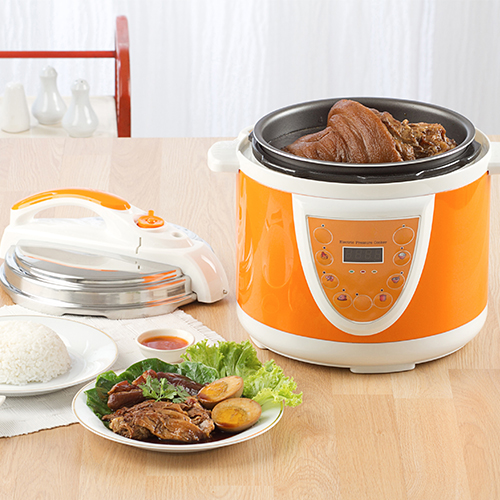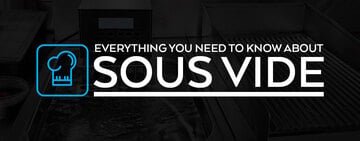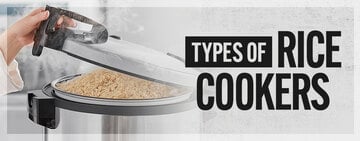
Everything You Need to Know about Commercial Pressure Cookers
Last updated on Jan 19, 2021
Are you interested in adding dishes prepared in a pressure cooker to your restaurant's menu? Maybe you've already started using one, but you're wondering whether these powerful cooking devices are safe? Do you know the wide variety of foods you can prepare using pressure cookers? Keep reading to learn the answers to some of the most frequently asked questions about pressure cookers!
Shop All Commercial Pressure CookersHow Do Pressure Cookers Work?
Essentially, a pressure cooker is a sealed pot that creates steam pressure by heating water. Pressure cookers keep the steam they generate inside of the pot, but they also allow excess steam to escape through a vent tube. As a result, pressure cookers automatically maintain a constant internal pressure to cook food quickly.
What Are the Benefits of Using Pressure Cookers?

If your chefs are preparing something wet - like steamed vegetables or seafood - via conventional cooking methods, the maximum heat they can achieve is limited to the boiling point of water (212 degrees Fahrenheit). However, adding steam pressure into the mix allows the boiling point to reach up to 250 degrees Fahrenheit, which helps your food cook faster. On average, for every 41-50 degrees Fahrenheit that the water temperature increases in the cooker, your food will cook twice as quickly.
Pressure cookers force liquid into food, helping it cook faster and allowing your cooks to quickly tenderize tough foods. Additionally, they also increase caramelization and browning due to the extra high heat they create, which allows you to create complex flavors. Some chefs will sear food before placing it in their pressure cookers. If you do this, be sure to scrape off the browning residue before adding the food to the cooking liquid to help prevent scorching.
What Is the History of Pressure Cookers?
What we now know as a pressure cooker was invented in the seventeenth century by a French scientist named Denis Papin. Papin was interested in bringing new discoveries about pressure and steam to cooking and called his pot "The Digester." However, these prototype products weren't very safe, and their use didn't become widespread until the advent of better technology and manufacturing standards.
Is It Safe to Use a Pressure Cooker?
When used properly, pressure cookers are as safe as any other method of preparing food. Most units also come equipped with several safety features and, should they malfunction, are designed to do so in a way that minimizes harm. However, you should never force your pressure cooker open, as this will damage your equipment and could even cause injury.
Ultimately, if your cooker's lid is closed, the lid handle is directly over the pan's handle, and the pressure control is gently jiggling, your cooker is safe to use and operating properly.
What Can I Use a Pressure Cooker For?

Pressure cookers can be used for both canning and cooking, making them an incredibly versatile tool. You can even branch out to pressure smokers and pressure steamers, too!
Pressure Canning
Pressure cookers are frequently used for canning because they kill dangerous bacteria that don't die at the normal boiling point of water. While you can use a traditional cooker for canning, many businesses use specialty pressure canning units that are often larger than pressure cookers. Additionally, pressure canners are frequently made from less expensive, uncoated aluminum due to the fact that canned foods are already stored in jars.
Pressure Cooking
Some chefs also use pressure cookers to prepare meat, as they can quickly achieve both tender and well done finished products. Additionally, they're ideal for tenderizing raw vegetables or making stews. As a general rule, pressure cookers aren't designed for foods that are supposed to be dry and crispy. You'll also want to avoid using them to cook delicate foods like lean fish, as they can easily be damaged by the intense pressure within the cooker.
How Much Liquid Should I Add to My Pressure Cooker?
Pressure cookers also allow you to get creative with cooking liquids because you can use water, wine, bouillon, fruit juices, beer, vegetable juices, or whatever else you can think of. When adding liquid to your pressure cooker, make sure to add at least the recommended amount. It's okay to use more liquid than your recipe calls for, but you should never use less. If you end up adding too much liquid, you can just cook in the uncovered cooker until you've reached the desired liquid level. Keep in mind that you should never fill the pressure cooker more than half full in order to avoid clogging the steam release vent during cooking.
What Is a Pressure Cooker Cooling Rack?
Pressure cooker cooling racks are designed to separate foods and hold them out of the cooking liquid to ensure the flavors won't blend. This is perfect for busy foodservice establishments because it allows you to cook two courses at the same time for maximized efficiency.
What Are the Differences Between Electric and Stovetop Pressure Cookers?

There are two main types of pressure cookers: electric and stovetop. Both have distinct advantages and disadvantages, so it's important to be informed before making a purchasing decision.
What Is an Electric Pressure Cooker?
Much like the name suggests, these cookers plug into the wall and are operated via electricity. These easy-to-use products are very portable, and they're guaranteed to never scorch their contents. Additionally, because they have built-in timers, your chefs don't need to be around to switch off the heat. Instead, electric pressure cookers go through a natural release cycle and automatically switch to a keep warm setting. Finally, the removable cooking pot in an electric cooker is usually dishwasher safe for effortless cleanup.
What Is a Stovetop Pressure Cooker?
Stovetop pressure cookers are generally able to reach higher levels of pressure than their electric counterparts, making them a desirable option for many chefs. This means they can also cook food more quickly than electric models, so they're great for high-volume establishments. While they're compatible with gas and electric ranges, keep in mind that most pressure cookers aren't magnetic and therefore won't work with induction equipment.
What Are the Differences Between Quick and Natural Pressure Release?
Depending upon the food you'll be preparing in your pressure cooker, you'll need to choose between quick and natural pressure release functions.
What Is Quick Pressure Release?
Simply put, quick pressure release allows users to expedite the process of finishing the cooking process. Operators should use a tool (not their hand) to pull the pressure limit valve forward, which will cause the pot to immediately begin releasing steam. Once the pressure is completely released, the indicator will drop and the lid of the cooker will unlock and can be safely opened. Keep in mind that using this pressure release style stops cooking immediately, but returning the unit to the pressure or simmer settings allows you to continue cooking if need be.
What Is Natural Pressure Release?
To release the pressure in your cooker naturally, set it to keep warm once you've finished using it. At that point, the pressure will begin to drop; the timing depends upon the amount of liquid in the cooker and the length of time pressure was maintained. Natural release generally takes 12-30 minutes, and cooking will continue during this period. When the pressure has been fully released, the indicator will drop and the lid will unlock.
What Can I Make in My Pressure Cooker?
In addition to meat and some seafood, here are just a few of the foods you can prepare using a pressure cooker:
- Beans
- Enchiladas and carnitas
- Frittatas and egg casseroles
- Macaroni and cheese
- Pasta and tomato sauce
- Ribs
- Rice, risotto, and rice pudding
- Soup, chili, and stew
There are a wealth of pressure cooker recipes out there, all of which can help you add variety to your existing menu. Additionally, chefs can prepare traditional stovetop dishes in pressure cookers. However, they should be sure to reduce the amount of liquid they use by 10-20%, since they won't lose any through evaporation. Additionally, cooks may want to cut down on the amount of seasoning they use due to the fact that the flavors of foods prepared in pressure cookers are more concentrated.
How Should I Store My Pressure Cooker?

It's very important to store your cooker with the lid completely detached and to the side. If you store it closed, unwanted odors can become trapped inside of the unit and affect the taste of the next dish you prepare with your pressure cooker. It's also recommended that you wash the rubber seal and rub it with mineral oil after each usage to extend its lifespan, which could be up to 150 meals.
From casseroles and meat dishes to desserts and soups, you can use a pressure cooker to quickly prepare a wide variety of foods. Before purchasing this handy product, though, it's important to know the answers to a range of frequently asked questions. Once you do, you can make an informed buying decision and start getting the most out of your new pressure cooker!





